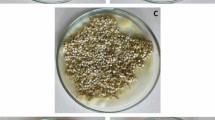Abstract
The effects of chitosan coating on extending postharvest life of loquat (Eriobotrya japonica) fruits and maintaining their quality were investigated. Fruits were treated 0, 0.25, 0.5, 0.75, and 1.0% (w/v) chitosan and then stored at 7°C with 88 ± 2% relative humidity for 28 days. Browning index, weight loss, total soluble solids (TSS), titratable acidity (TA), vitamin C, phenolic compounds, total polyphenols, and antioxidant activity in fruits were measured. The chitosan coating significantly reduced weight loss and suppressed flesh browning of fruits during cold storage as compared to control and the most effective chitosan concentration was 0.75%. The storage for 28 days at 7°C significantly increased TSS, TSS/TA ratio, pH, and vitamin C. However, the fruits treaded with 0.75 and 1.0% chitosan exhibited the higher values of those. Chitosan coating also induced total polyphenol and phenolic compounds such as catachin and quercetin and maintained antioxidant capacity in fruits during cold storage. Overall, the results demonstrated that the chitosan coating followed by cold storage significantly extended fruit storage life and maintained the quality.
Similar content being viewed by others
Literature Cited
Allan, C.R. and L.A. Hadwiger. 1979. The fungicidal effect of chitosan on fungi of varying cell wall composition. Exp. Mycol. 3:285–287.
Arthey, D. and R.A. Philip. 2005. Fruit processing nutrition, product, and quality management. 2nd edn., Brijbasi Art Press Ltd., Noida, India.
Baldwin, E.A. 1994. Edible coatings for fresh fruit and vegetables: Past, present, and future, p. 201–277. In: J.M. Krochta, E.A. Baldwin, and M.O. Nisperos-Carriedo (eds.). Edible coatings and films to improve food quality. Technomic Publ. Co., Lancaster, PA, USA.
Bautista-Banos, S., A.N. Hernández-Lauzardo, M.G. Velázquez-del Valle, M. Hernandez- López, E. Ait Barka, E. Bosquez-Molina, and C.L. Wilson. 2006. Chitosan as a potential natural compound to control pre and postharvest diseases of horticultural commodities. Crop Protec. 25:108–118.
Bautista-Banos, S., M. Hernandez-López, E. Bosquez-Molina, and C.L. Wilson. 2003. Effects of chitosan and plant extracts on growth of Colletotrichum gloeosporioides, anthracnose levels, and quality of papaya fruit. Crop Protec. 22:1087–1092.
Blumenfeld, A. 1980. Fruit growth of loquat. J. Amer. Soc. Hort. Sci. 105:747–750.
Cao, S.F., Y.H. Zheng, Z.F. Yang, N. Li, S.J. Ma, S.S. Tang, and J.H. Zhang. 2007. Effects of storage temperature on antioxidant composition and antioxidant activity of loquat fruit. Acta Hort. 750:471–476.
Chong, C., C. Xua, L. Shan, X. Li, C. Zhoua, W. Zhang, I. Ferguson, and K. Chena. 2006. Low temperature conditioning reduces postharvest chilling injury in loquat fruit. Postharvest Biol. Technol. 41:252–259.
Cook, N.C. and S. Samman. 1996. Flavonoids chemistry, metabolism, cardioprotective effects, and dietary sources. J. Nutr. Biochem. 7:66–76.
Cordenunsi, B.R., M.I. Genovese, J.R. Hassimotto, R.J. Santos, and F.M. Lajolo. 2005. Effects of temperature on the chemical composition and antioxidant activity of three strawberry cultivars. Food Chem. 91:113–121.
Dewanto, V., K. K. Adom, and R.H. Liu. 2002. Thermal processing enhances the nutritional value of tomatoes by increasing total antioxidant activity. J. Agr. Food Chem. 50:3010–3014.
Ding, C.K., K. Chachin, Y. Hamauzu, Y. Ueda, and Y. Imahori. 1998. Effects of storage temperatures on physiology and quality of loquat fruit. Postharvest Biol. Technol. 14:309–315.
Ding, C.K., K. Chachin, Y. Ueda, Y. Imahori, and C.Y. Wang. 2002. Modified atmosphere packaging maintains postharvest quality of loquat fruit. Postharvest Biol. Technol. 24:341–348.
Echeverria, E. and J. Valich. 1989. Enzymes of sugar and acid metabolism in stored Valencia organs. J. Amer. Soc. Hort. Sci. 114:445–449.
El Ghaouth, A., J. Arul, C. Wilson, and N. Behamou. 1997. Biochemical and cytochemical aspects of the interaction of chitosan and Botrytis cinerea in bell pepper fruit. Postharvest Biol. Technol. 12:183–194.
El Ghaouth, A., J. Arul, C. Wilson, A. Asselin, and N. Benhamou. 1994. Ultrastructural and cytochemical aspects of the effect of chitosan on decay of bell pepper fruit. Physiol. Mol. Plant Pathol. 44:417–432.
El Ghaouth, A., R. Ponnampalam, F. Castaigne, and J. Arul. 1992. Chitosan coating to extend the storage life of tomatoes. HortScience 27:1016–1018.
Han, C., Y. Zhao, S.W. Leonard, and M.G. Traber. 2004. Edible coatings to improve storability and enhance nutritional value of fresh and frozen strawberries (Fragaria × ananassa) and raspberries (Rubusideaus). Postharvest Biol. Technol. 33:67–78.
Kazunori, K., A. Matsuoka, K. Osada, and Y. Huang. 2007. Effect of loquat (Eriobotrya japonica) extracts on LDL oxidation. Food Chem. 104:308–316.
Li, H. and T, Yu. 2000. Effect of chitosan on incidence of brown rot, quality, and physiological attributes of postharvest peach fruit. J. Sci. Food Agr. 81:269–274.
Lin, S., R.H. Sharpe, and J. Janick. 1999. Loquat: Botany and horticulture. Hort. Rev. 23:233–276.
Middleton, E.J. and C. Kandaswani. 1992. Effects of flavonoids on immune and inflammatory cell functions. Biochem. Pharmacol. 43:1167–1179.
Shaw, P.E. 1980. Loquat, p. 480–481. In: S. Nagy and P.E. Shaw (eds.). Tropical and subtropical fruits. AVI Publ. Co., Westport, CT, USA.
Srinivasa, P.C., R. Baskaran, M.N. Armes, K.V.H. Prashanth, and R.N. Tharanathan. 2002. Storage studies of mango packed using biodegradable chitosan. Eur. Food Res. Technol. 215:504–508.
Zheng, Y.H. and Y.F. Xi. 1999. A study on the relationship between the changes of postharvest membrane permeability, respiration rate, and ethylene production and the storability of loquat fruit. J. Jiangxi Agr.Univ. 21:81–82.
Zheng, Y.H., S.Y. Li, and Y.F. Xi. 2000. Changes of cell wall substances in relation to flesh woodiness in cold-stored loquat fruits. Acta Phytophysiol. 26:306–310.
Author information
Authors and Affiliations
Corresponding author
Rights and permissions
About this article
Cite this article
Ghasemnezhad, M., Nezhad, M.A. & Gerailoo, S. Changes in postharvest quality of loquat (Eriobotrya japonica) fruits influenced by chitosan. Hortic. Environ. Biotechnol. 52, 40–45 (2011). https://doi.org/10.1007/s13580-011-0028-5
Received:
Accepted:
Published:
Issue Date:
DOI: https://doi.org/10.1007/s13580-011-0028-5




